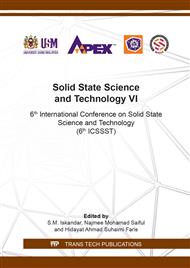[1]
S.S. Sastry, B.R. Venkateswara, Spectroscopic studies of copper doped alkaline earth lead zinc phosphate glasses, Phys. B Phys. Condens. Matter. 434 (2014) 159–164.
DOI: 10.1016/j.physb.2013.11.017
Google Scholar
[2]
S.V.G.V.A. Prasad, M.S. Reddy, V.R. Kumar, N.Ã. Veeraiah, Specific features of photo and thermoluminescence of Tb3+ ions in BaO – M2O3 ( M = Ga , Al , In )– P2 O 5 glasses, J.Lumin. 127 (2007) 637–644.
DOI: 10.1016/j.jlumin.2007.03.011
Google Scholar
[3]
C.R. Kesavulu, A.C. Almeida Silva, M.R. Dousti, N.O. Dantas, A. S.S. de Camargo, T. Catunda, Concentration effect on the spectroscopic behavior of Tb3+ ions in zinc phosphate glasses, J. Lumin. 165 (2015) 77–84.
DOI: 10.1016/j.jlumin.2015.04.012
Google Scholar
[4]
S.F. Khor, Z.A. Talib, W.M. Mat Yunus, Optical properties of ternary zinc magnesium phosphate glasses, Ceram. Int. 38 (2012) 935–940.
DOI: 10.1016/j.ceramint.2011.08.013
Google Scholar
[5]
M.R. Dousti, R.J. Amjad, Spectroscopic properties of Tb3+ -doped lead zinc phosphate glass for green solid state laser, J. Non. Cryst. Solids. 420 (2015) 21–25.
DOI: 10.1016/j.jnoncrysol.2015.04.002
Google Scholar
[6]
S.S. Syamchand, G. Sony, Europium enabled luminescent nanoparticles for biomedical applications, J. Lumin. 165 (2015) 190–215.
DOI: 10.1016/j.jlumin.2015.04.042
Google Scholar
[7]
S.W. Yung, H.Y. Chiang, Y.S. Lai, F.B. Wu, C. Fu, Y. Lee, Thermal , optical and structural properties of Tb doped zinc aluminum phosphate glasses, 41 (2015) 877-888.
DOI: 10.1016/j.ceramint.2014.09.005
Google Scholar
[8]
A. Awang, S.K. Ghoshal, M.R. Sahar, R. Ari, F. Nawaz, Non-spherical gold nanoparticles mediated surface plasmon resonance in Er 3+ doped zinc – sodium tellurite glasses : Role of heat treatment, J. Lumin 149 (2014) 138–143.
DOI: 10.1016/j.jlumin.2014.01.027
Google Scholar
[9]
V.S. Gurin, A.A. Alexeenko, A. V Kaparikha, Fabrication and optical features of the sol – gel derived silica glasses doped with copper oxide nanoparticles and europium,J.Mater.Let 65 (2011) 2442–2444.
DOI: 10.1016/j.matlet.2011.04.098
Google Scholar
[10]
T. Satyanarayana, G. Nagarjuna, K. Ravi Kiran, Spectral features of lead arsenate glasses doped with copper oxide, Solid State Phenom. 207 (2014) 55–67.
DOI: 10.4028/www.scientific.net/ssp.207.55
Google Scholar
[11]
S.F. Ismail, M.R. Sahar, S.K. Ghoshal, Materials Characterization Physical and absorption properties of titanium nanoparticles incorporated into zinc magnesium phosphate glass, Mater. Charact. 111 (2016) 177–182.
DOI: 10.1016/j.matchar.2015.11.030
Google Scholar
[12]
N.S.A. El-Aal, H.A. Afifi, Structure and Ultrasonic Properties of Vanadium Tellurite Glasses Containing Copper Oxide, Arch. Acoust. 34 (2009) 641–654.
Google Scholar
[13]
M.A.A.M. Sultan, O.M.S.A. Elwhab, Electronic polarizability , optical basicity and interaction parameter for Nd2O3 doped lithium – zinc – phosphate glasses, Appl. Phys. A. 123 (2017) 1–12.
DOI: 10.1007/s00339-017-1136-6
Google Scholar
[14]
G. Upender, S. Ramesh, M. Prasad, V.G. Sathe, V.C. Mouli, Optical band gap, glass transition temperature and structural studies of (100−2x)TeO2–xAg2O–xWO3 glass system, J. Alloys Compd. 504 (2010) 468–474.
DOI: 10.1016/j.jallcom.2010.06.006
Google Scholar
[15]
N. Aboulfotoh, Y. Elbashar, M. Ibrahem, M. Elokr, Characterization of copper doped phosphate glasses for optical applications, Ceram. Int. 40 (2014) 10395–10399.
DOI: 10.1016/j.ceramint.2014.02.125
Google Scholar
[16]
U.B. Chanshetti, V. Sudarsan, M.S. Jogad, T.K. Chondhekar, Effect of CuO addition on the optical and electrical properties of sodium zinc borophosphate glasses, Phys. B Condens. Matter. 406 (2011) 2904–2907.
DOI: 10.1016/j.physb.2011.04.063
Google Scholar
[17]
A.M. Noorazlan, H.M. Kamari, S.S. Zulkefly, D.W. Mohamad, Effect of Erbium Nanoparticles on Optical Properties of Zinc Borotellurite Glass System, J. Nanomater.2013 (2013).
DOI: 10.1155/2013/940917
Google Scholar
[18]
H.K. Obayes, H. Wagiran, R. Hussin, M.A. Saeed, Structural and optical properties of strontium / copper co-doped lithium borate glass system, Jmade. 94 (2016) 121–131.
DOI: 10.1016/j.matdes.2016.01.018
Google Scholar
[19]
G. Sharma, K.S. Thind, Manupriya, H.S. Klare, S.B. Narang, L. Gerward, V.K. Dangwal, Effects of gamma-ray irradiation on optical properties of ZnO-PbO-B2O3 glasses, Nucl. Instruments Methods Phys. Res. Sect. B Beam Interact. with Mater. Atoms. 243 (2006) 345–348.
DOI: 10.1016/j.nimb.2005.08.157
Google Scholar


